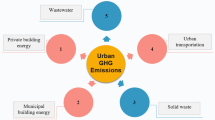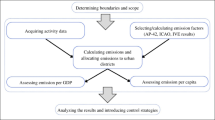Abstract
A comprehensive emission inventory (EI) was conducted in Ho Chi Minh City (HCMC), the largest city of Vietnam rapid urbanization rate. In 2017, HCMC had 8.6 million inhabitants with a total of nine millions of private vehicles, 19 manufacturing and industrial zones, 30 industrial clusters, and numerous other factories and enterprises. All those sources could contribute to the high levels of emissions which caused the potentially negative impact on human health and environment. The aims of this study were (i) application bottom-up and top-down approaches to conduct a complete air emission inventory, (ii) development of spatial distribution of air emission, and (iii) estimation of emission forecast for HCMC by 2025 and 2030. A combination of bottom-up and top-down approaches was employed to conduct air pollution EI, in which EMISENS model was utilized to generate the EI for road traffic sources. The results showed that the motorcycles were the main reasons of emission in HCMC, contributing 90% of CO, 68% of non-methane volatile organic compounds (NMVOC), 63% of CH4, 41% of SO2, 29% of NOx, and 18% of patriculate matter (PM2.5). The emission forecasts for HCMC by 2025 and 2030 also were calculated based on the data of strategies and plans for socioeconomic development of HCMC. The results showed that the emissions of pollutants will increase around 30 to 50% by the year 2025 and from 40 to 65% by the year 2030. If the local government does not have any plan for the reduction of emissions (scenario of socioeconomic development as usual), the emissions will increase significantly.






Similar content being viewed by others
References
Bang HQ (2017) Modeling PM10 in Ho Chi Minh city, Vietnam and evaluation of its impact on human health. Sustain Environ Res 27(2):95–102. https://doi.org/10.1016/j.serj.2017.01.001
Bang HQ, Clappier A (2011) Road traffic emission inventory for air quality modelling and to evaluate the abatement strategies: a case of Ho Chi Minh city, Vietnam. Atmos Environ 45(21):3584–3593. https://doi.org/10.1016/j.atmosenv.2011.03.073
Bang HQ, Clappier A, Golay F (2011) Air pollution forecast for Ho Chi Minh City, Vietnam in 2015 and 2020. Air Qual Atmos Health 4(2):145–158. https://doi.org/10.1007/s11869-010-0087-2
Bang HQ, Khue VHN, Tam NT, Lasko K (2018) Air pollution emission inventory and air quality modeling for Can Tho City, Mekong Delta, Vietnam. Air Qual Atmos Health 11(1):35–47. https://doi.org/10.1007/s11869-017-0512-x
Belalcazar LC, Fuhrer O, Dung MH, Zarate E, Clappier A (2009) Estimation of road traffic emission factors from a long term tracer study in Ho Chi Minh city (Vietnam). Atmos Environ 43(36):5830–5837. https://doi.org/10.1016/j.atmosenv.2009.07.059
Cornet B, Bang HQ (2017) Air emission inventories for smaller cities in ASEAN region: findings and sensitivities. Air Qual Atmos Health 10(7):1–10. https://doi.org/10.1007/s11869-017-0479-7
de Never N (2016) Air pollution control engineering, 3rd edn. Waveland Press, Inc, Long Grove
Department of Science, Technology and Environment of Ho Chi Minh city (DOSTE) (2001) Urban transport energy demand and emission analysis e case study of Ho Chi Minh city. No 1 (phase II)
Dung HM, Thang DX (2008) Estimation of emission factors of air pollutants from the road traffic in Ho Chi Minh City. VNU J Sci Earth Sci 24(4):184–192
European Environment Agency (EEA) (2016) EMEP/CORINAIR, Emission inventory guidebook
GIZ (2015) Clean air for smaller cities in Asian region project. Technical report, 201 pages
Health Effects Institute (HEI) (2012) Effects of short-term exposure to air pollution on hospital admissions of young children for acute lower respiratory infections in Ho Chi Minh city, Vietnam. Health Effects Institute, Boston
HCMC People’s Committee (2017) HCMC’s socio-economic situation report in 2017, tasks, and solutions for 2018.
Intergovernmental Panel on Climate Change (IPCC) (2006) Guidelines for National Greenhouse Gas Inventories (IPCC Guidelines)
International Civil Aviation Organization (ICAO) (2011) Airport air quality manual, 1st edition
Kurokawa J, Ohara T, Morikawa T, Hanayama S, Janssens-Maenhout G, Fukui T, Kawashima K, Akimoto H (2013) Emissions of air pollutants and greenhouse gases over Asian regions during 2000–2008: regional emission inventory in ASia (REAS) version 2. Atmos Chem Phys 13:11019–11058. https://doi.org/10.5194/acp-13-11019-2013
Mehta S, Ngo LNV, Dzung DV, Cohen A, Thach TQ, Dan VX, Tuan ND, Giang LT (2013) Air pollution and admissions for acute lower respiratory infections in young children of Ho Chi Minh City. Air Qual Atmos Health 6(1):167–179. https://doi.org/10.1007/s11869-011-0158-z
Ministry of Nature Resource and Environment (MONRE) (2017) National state of environment report 2016 on air quality vietnam environment administration
Streets DG, Bond TC, Carmichael GR, Fernandes SD, Fu Q, He D, Klimont Z, Nelson SM, Tsai NY, Wang MQ, Woo J-H, Yarber KF (2003) An inventory of gaseous and primary aerosol emissions in asia in the year 2000. J Geophys Res 108(D21):8809, GTE 30. https://doi.org/10.1029/2002JD003093
United States Environmental Protection Agency (US.EPA) (2009) Emission factor documentation for AP-42
Zemankova K, Brechler J (2010) Emissions of biogenic VOC from forest ecosystems in central europe: estimation and comparison with anthropogenic emission inventory. Environ Pollut 158(2):462–469. https://doi.org/10.1016/j.envpol.2009.08.032
Funding
This research is funded by Vietnam National University Ho Chi Minh City (VNU-HCM) under grant number B2019-24-01.
Author information
Authors and Affiliations
Contributions
Prof. Bang Ho contributes as coordinator for whole research and air quality modeling and develops abatement strategies. Ms. Khue Vu contributes to air emission inventory for the transportation sector and preparing this manuscript. Mr. Tam Nguyen contributes to air emission inventory for the industrial sector. Ms. Hang Nguyen contributes to air emission inventory for the residential sector. Ms. Thuy Nguyen contributes to coordinate the air emission inventory group and compilation emission factors and together with Ms. Khue Nguyen to prepare this manuscript.
Corresponding author
Ethics declarations
Conflict of interest
The authors declare that they have no conflict of interest.
Additional information
Publisher’s note
Springer Nature remains neutral with regard to jurisdictional claims in published maps and institutional affiliations.
Electronic supplementary material
ESM 1
(DOCX 96 kb)
Rights and permissions
About this article
Cite this article
Ho, Q.B., Vu, H.N.K., Nguyen, T.T. et al. A combination of bottom-up and top-down approaches for calculating of air emission for developing countries: a case of Ho Chi Minh City, Vietnam. Air Qual Atmos Health 12, 1059–1072 (2019). https://doi.org/10.1007/s11869-019-00722-8
Received:
Accepted:
Published:
Issue Date:
DOI: https://doi.org/10.1007/s11869-019-00722-8




